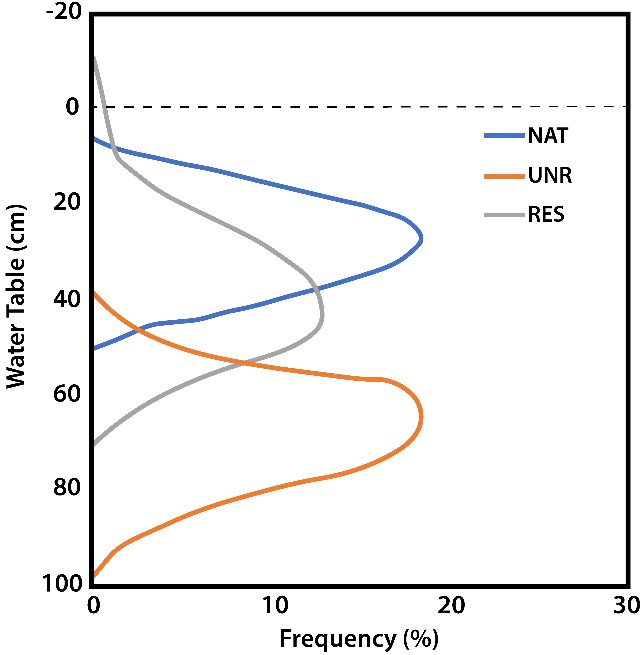6.2 Peat Harvesting and Restoration
Peat harvesting typically occurs on Sphagnum dominated bogs, since Sphagnum moss is generally the preferred soil amendment for horticulture. At peat harvesting sites, drainage ditches are installed to decrease the water content of the peat and increase the bearing capacity for machines to access the site. Ditch spacing is commonly ~30 m, but narrower spacing is required for denser (low hydraulic conductivity) peat. The surface material (living and dead but poorly decomposed peat forming vegetation) is typically stripped to access the peat, and the underlying peat is removed in blocks or extruded—but nowadays is typically remove by vacuum harvesting.
For the latter, the surface is harrowed to break the capillary connection of the surface material from the underlying water source; this is allowed to dry in the sun and wind, then collected with industrial vacuums. At a peat extraction site in Canada (Bois-des-Bel, Quebec), median water table depth was ~65 cm, in contrast to an unharvested part of the same bog, where the median water table was ~25 cm (Figure 20).

Figure 20 – Water table depth frequency at a natural bog site (NAT), a drained unrestored site (UNR), and a restored site (RES). For the natural and unrestored sites, the surface (dashed line) is at 0 cm. For the restored site, at which a ~15 cm layer of moss had regenerated, the interface between the cutover surface and regenerated moss is also shown at 0 cm; the regenerated moss occurred above that (Based on data from McCarter and Price, 2013).
Water table variation is greater at harvested sites, mostly because the drainable porosity of peat is reduced to ~0.05 from 0.35 to 0.55 in undisturbed peat (Price, 1996), due to peat consolidation caused by the lowered water table (decreased pore water pressure) and weight of machinery, as well as enhanced decomposition caused by aeration. Restoration of these degraded systems requires blockage of drainage ditches to reduce water loss. However, because of subsidence or peat cutting that alters the natural surface profile, as well as the altered hydraulic properties of the peat matrix, “normal” water table relations are not re-established until Sphagnum mosses regenerate sufficiently and become partially decomposed at their base, so that the hydraulic properties with depth transition in a similar manner to that in an undisturbed system (Taylor and Price, 2015).
While mosses are slow to regenerate on cutover peat, they can be introduced as part of the restoration process. Since Sphagnum mosses are non-vascular, connectivity between deeper peat and the surface relies on capillary rise of water through the matrix. However, in the early stages of regeneration, the compacted and more decomposed underlying cutover peat transitions abruptly to the mosses introduced for reestablishment. The result is a capillary barrier that restricts upward movement of moisture from the peat to the mosses (McCarter and Price, 2015), thus potentially restricting their growth and resilience.
